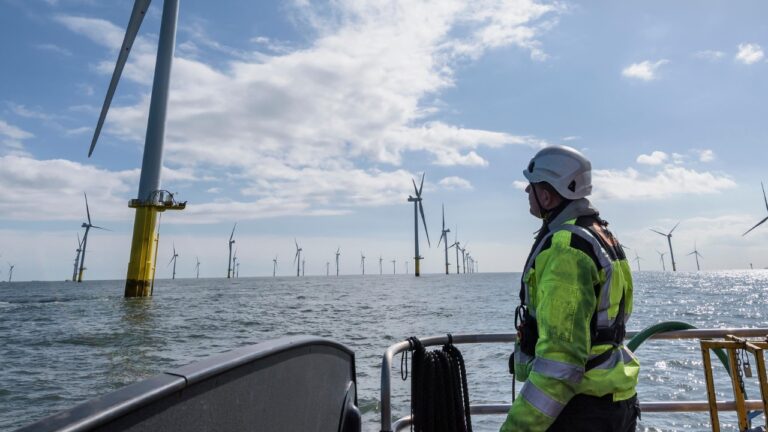
Ed Birkett
Head of Energy and Environment (2020-2022)

Josh Buckland
Senior Fellow, Energy & Environment
It’s a formidable in-tray for new Energy Minister Greg Hands, who will benefit from working alongside BEIS Secretary Kwasi Kwarteng, a former Energy Minister himself.
The immediate energy crisis is a liquidity crunch amongst UK energy suppliers. Suppliers have been in crisis talks with the Government over how to handle the expected failure of several energy suppliers in the coming weeks.
Many suppliers are facing severe financial challenges because rising wholesale prices mean that the cost of serving many customers is now higher than the price that they are charging. Suppliers cannot immediately raise prices to cover these increased costs due to a combination of:
- The energy price cap, set by the regulator Ofgem. The energy price cap limits the price that suppliers can charge to customers. The price cap is currently less than the cost of serving customers and will only be updated in April 2022.
- Customers on fixed price deals. Many customers have signed up for fixed price deals lasting 12 months or more. If Suppliers have not bought enough energy in advance (known as “hedging”), then they will need to buy more in the short-term markets, where prices are currently high.
The solution to the immediate challenges facing the retail market is likely to be a combination of weaker suppliers exiting the market, plus incentives for stronger suppliers to take on new customers.
The current “liquidity crunch” may be followed by an “affordability crunch”.
Once the current liquidity crunch abates, the Government faces a potentially greater challenge in the form of an affordability crunch, which is the focus of this blog.
Rising wholesale energy prices have already fed through into higher bills for customers, with many of the best fixed-price deals withdrawn and the energy price cap going up by £139 per year for a typical household from the start of October.
The energy price cap partially insulates customers from further price rises until the cap is revised in April next year. When the price is updated, there are concerns that it could rise by £200-£300 per year or even more, which could see many households struggling to pay their energy bills.
In other European markets, price rises have fed through to customer bills more quickly, and governments have already had to take action on the affordability crunch.
For example, the Spanish Government has implemented a temporary tax cut on energy bills, plus an emergency tax hike on those energy companies that have profited from the recent rises in the price of gas and electricity.
This approach risks damaging investor confidence in the Spanish energy sector, with investors already burnt by previous retrospective cuts in subsidies for wind and solar plants. Given the amount of new investment required in new green energy projects over coming decades, the Spanish Government’s approach should clearly not be copied in the UK.
But, given the scale of the coming price rises, it is clear that the Government will have to act. There are few easy options for the UK Government to address the affordability crunch, and all involve trade-offs.
Given that the Government has so far ruled out wider changes to taxes and benefit such as Universal Credit, we think there are five key areas that the Government could consider making changes before the price cap rises in April 2022:
#1: An emergency “price freeze”
Instead of allowing the price cap to rise in line with wholesale prices in April 2022, the Government could direct Ofgem to freeze the price cap at the current level. This would be similar to Ed Miliband’s pledge in the 2015 Labour Manifesto to freeze prices for two years.
This approach is not feasible, as it would put unbearable pressure on suppliers that make it through the winter. This could cause systemic failure in the market, leading to the Government having to renationalise large swathes of the retail energy market.
#2: Bill rebates
The Government could intervene to reduce prices either by directly subsidising energy bills or by removing the cost of social and environmental levies on energy bills; these levies would be funded by Government borrowing or general taxation. Some energy suppliers and MPs have advocated for cutting levies from customer bills.
In 2014 and 2015, the Government gave customers a rebate of £12 per customer each year to lower the “impacts of government environmental and social policy costs on consumer energy bills.” The rebate cost the Government £620m over two years.
However, the current increase in wholesale energy prices means that the rebates required would be in the order of £200-£300 per year or higher. This would cost around £5.6-8.4bn per year.[1]
Expenditure on this scale is unlikely to be feasible, given other pressures on the public finances.
As an alternative, the Government could consider structuring any rebate as a loan rather than a grant. For example, the Government could reduce energy bills by £200-300 next year and recover this over five years through a levy of £40-60 per customer per year, plus a small premium for interest costs.
#3: Defer investment in energy networks, renewables and energy efficiency.
The Net Zero agenda is driving significant investment in energy networks, renewable energy projects, and energy efficiency projects. These initiatives are largely paid for through energy bills through a combination of “network charges”, green levies, and the Energy Company Obligation (ECO) scheme for energy efficiency.
In theory, the Government could defer a portion of this investment to reduce energy bills. However, Net Zero means that these costs will still need to be incurred in future years, so this would just kick the can down the road and potentially increase the overall cost of the transition.
In addition, any cuts to new renewable energy projects could actually increase energy bills; current wholesale electricity prices are significantly higher than the cost of new offshore wind farms, which means that these offshore wind farms are likely to pay back to customers rather than increasing bills.
#4: Emergency cut to carbon prices
The UK’s Emissions Trading Scheme (UK ETS) incentivises energy companies to use lower-carbon forms of production, in particular using gas rather than coal. The cost of the UK ETS is passed through to customers via their energy bills.
Now that the UK has left the EU, the Government has more control over carbon prices. For example, the Government could temporarily cap prices or suspend the UK ETS. However, carbon pricing makes up a relatively small portion of energy bills, so the impact would be relatively modest.
This goes without mentioning the huge damage that any changes to the UK ETS would do to the confidence of investors in the UK energy sector and to the UK’s international reputation in the run up to hosting the COP26 climate conference in November.
#5: Increase existing discounts for the fuel poor
Some low-income energy customers in the UK already receive a rebate of £140 per year through the “Warm Homes Discount” (WHD) scheme.
To help those least able to afford rising energy bills, the Government could increase the level of the Warm Homes Discount; the WHD would need to more than double to offset likely increases in energy bills from April next year.
The advantage of using the WHD to reduce bills is that it targets those customers most in need of support. The downside of the WHD is that it requires some customers to opt-in, which means that some of those most in need will inevitably miss out.
The WHD is currently funded through a levy on all energy customers, meaning that any increase in the WHD would further increase energy bills for those customers not eligible for the discount. To avoid this, a temporary increase in the WHD could be structured as a loan to be repaid by all customers over the next five or so years.
Expanding support for the fuel poor is likely the most attractive option
Several of the options set out above are not viable, as they would lead to the widespread failure of the retail market (Option #1: price freeze), delay the transition to Net Zero (Option #3: defer investment), or damage investor confidence (Option #4: cut carbon prices).
This means the Government is more likely to consider a temporary rebate for all customers (Option #2) or temporary additional support for low-income customers (Option #5). An across-the-board cut in energy bills (Option #2) is unlikely to be viable due to the pressure it would place on the public finances, even if support was structured as a loan.
The most attractive option is therefore likely to be a temporary increase in the Warm Homes Discount. This will target support at those who need it most, although it will lead to a relatively small increase in energy bills for those who do not receive the discount. If the Government is concerned about the impact on those who do not receive WHD, it should consider structuring increased WHD payments as a loan or paying it directly through the Exchequer.
Longer term action cannot wait
Even once the Government takes action to mitigate the liquidity and affordability crunches, the current energy crisis will inevitably lead to questions about how to develop a more sustainable energy market that is more resilient to inevitable future crises.
Policy Exchange argued in a report last year that the Government should prioritise reforming the structure of Great Britain’s electricity market to reduce bills. This argument has recently been made by former BEIS Secretary Dame Andrea Leadsom MP in an article for ConHome, and by former Secretary of State for Energy and Climate Change Amber Rudd at a recent Policy Exchange event.
The Government is right to prioritise tackling the short-term issues in the energy market; However, once these abate, the Government’s attention must turn to ensuring that the UK’s energy market is fit for purpose for the long term.
[1] Based on approximately 28 million households receiving a rebate of £200-£300 per year.


